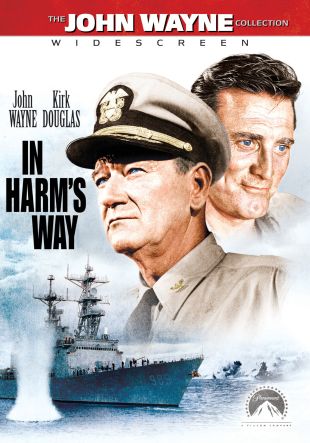
In Harm's Way has endured extraordinarily well for an epic war movie made in the 1960s, owing to a multitude of virtues. For starters, it was the last big-budget, all-star Hollywood movie to be shot in black-and-white, and that gives the film a harder, sharper, more defined edge than it ever could have had if it had been photographed in color. It was also shot in Panavision (and it should be seen letterboxed), and cinematographer Loyal Griggs (who was nominated for an Oscar), production designer Lyle Wheeler, and director Otto Preminger use every inch of that widescreen image to tell their story. Additionally, Preminger's decision to shoot the movie on actual locations, and to use actual naval personnel throughout the film as extras and in small speaking roles, also gave the movie an immediacy and a verisimilitude that is striking, as well as unique among films dealing with this subject on this scale. From the first moments aboard Captain Torrey's cruiser, Old Swayback, the willing suspension of disbelief kicks in effortlessly as actual sailors go about their business, including rushing to battle stations, and appear more realistic than any group of actors ever could. Indeed, one gets the sense of watching a near-documentary, not far removed from the same kind of illusion achieved on a different scale in Richard Lester's A Hard Day's Night.
Preminger and screenwriter Wendell Mayes also capture important little details that some modern filmmakers (including the makers of the 2001 feature Pearl Harbor) overlook entirely, such as the civilian chaos ensuing after the Japanese attack on Pearl Harbor. In one compelling scene, while Kirk Douglas' Paul Eddington is seen in the foreground on the right side of the screen, claiming the effects of his wife (who died while cavorting with a Marine Corps officer the morning of the attack), a Japanese-American woman is seen on the left-hand side of the screen, in medium shot, frantically trying to find out what has happened to her son. Perhaps the most amazing element of the movie, however, is Preminger's success in getting his actors to melt into their roles. He had a deep, and totally interwoven understanding of his characters, story, and setting, and it comes out in the little nuances. Some of this can be attributed to James Bassett's original book and Mayes' surprisingly faithful (albeit simplified) screenplay, but ultimately it has to be on the screen. A perfect example: When the Old Swayback is hit by torpedoes, and Kirk Douglas' Eddington, just back from damage control, remarks, "We've got us a gut-bustin', mother-lovin' navy war," the glints in his and Torrey's eyes capture perfectly how many career navy officers felt at that point. The United States Navy had found little to do during World War I, and by 1941, it had been four decades since its ships or men had seen any combat action; a lot of career navy men saw this as the chance of a lifetime.

Even small parts, such as Bruce Cabot's portrayal of a quartermaster on McConnel's destroyer, and James Mitchum's one scene as an ensign on the cruiser, are memorable. Most of the characters are very well developed, and there's another surprise there; John Wayne plays a deeply flawed yet heroic figure, his personal life a shambles and his career not much different. He seems, very subtly, almost close to tears at times, without sacrificing his toughness; the part of Torrey was one of the most tragedy-laden of Wayne's career, his character's personal life and naval career both in shambles for most of the movie, losing one real son and one surrogate son (in Douglas' Eddington) in the course of the action, and then getting rescued by another surrogate son (Tom Tryon's McConnel). Similarly, Kirk Douglas' portrayal of Eddington crawls with near-psychopathic anger just below the surface, only visible once or twice onscreen but always lurking nearby. Each character has important motivating flaws that fit neatly and quietly into the action and affect the story in quiet but critical ways, and all are engrossing on their own terms. Additionally, this is one of the few fictionalized war movies of its kind that holds up to the scrutiny of historians, since Bassett's book and Mayes' screenplay both based their action on real-life strategies and planning, and the final battle is essentially a retelling of the Battle of Leyte Gulf. Add to those virtues the unexpectedly lively pacing and stunning special effects (the naval combat scenes were shot aboard seven different ships and augmented by generally excellent model work, and the final battle is a bone-rattling affair), and In Harm's Way seems like a very fast-moving two and a half hours.
